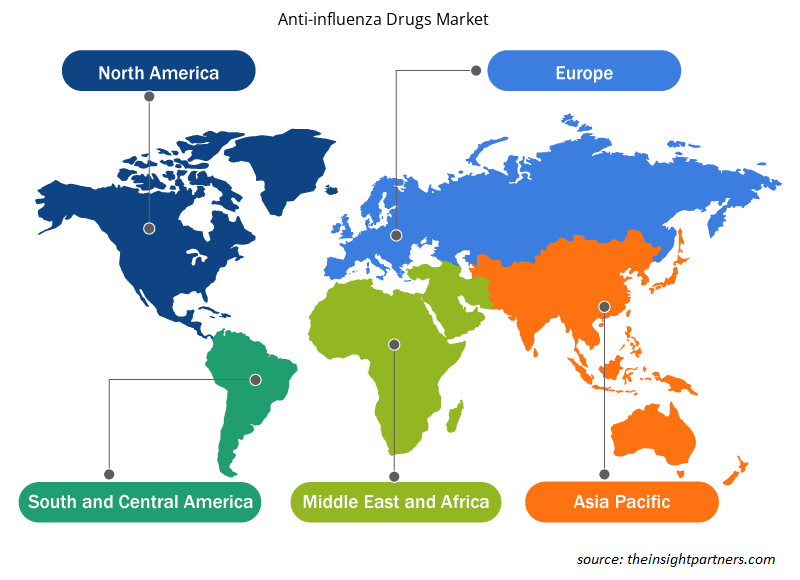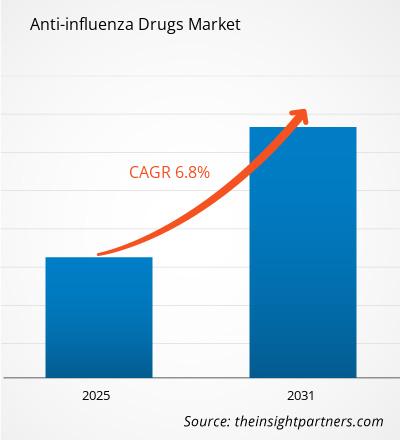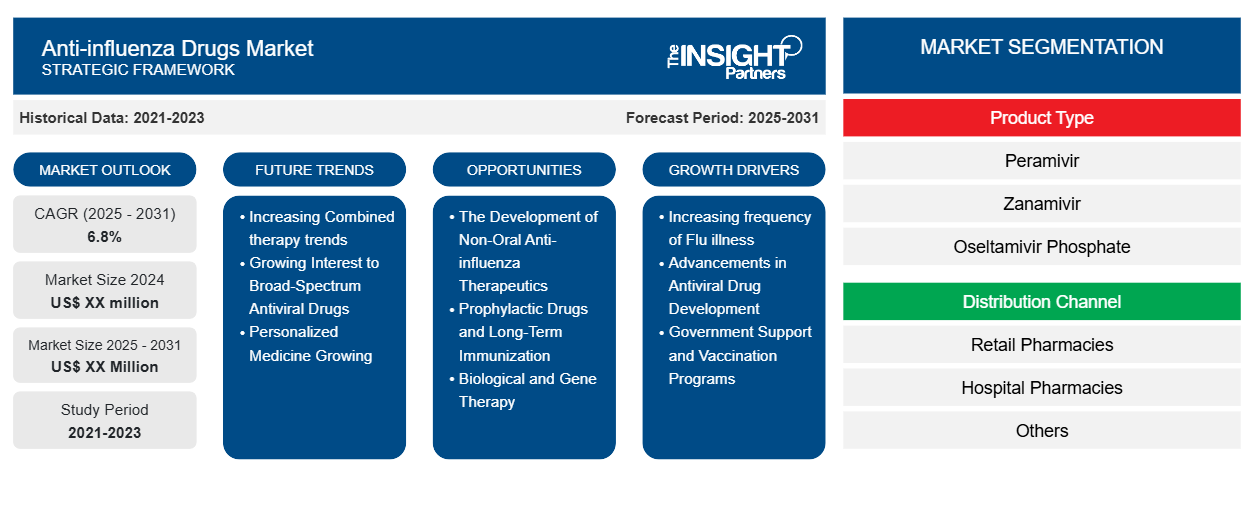抗流感药物市场预计在 2024 年至 2031 年期间的复合年增长率为 6.8%,市场规模将从 2024 年的 XX 百万美元扩大到 2031 年的 XX 百万美元。
报告按产品类型(帕拉米韦、扎那米韦、磷酸奥司他韦、巴洛沙韦马波西酯和其他产品)进行细分。报告进一步根据分销渠道(零售药店、医院药店和其他)进行分析。全球分析进一步细分为区域和主要国家。报告以美元为单位提供上述分析和细分的价值。
报告目的
Insight Partners 的《抗流感药物市场》报告旨在描述当前形势和未来增长、主要驱动因素、挑战和机遇。这将为各种商业利益相关者提供见解,例如:
- 技术提供商/制造商:了解不断变化的市场动态并了解潜在的增长机会,从而能够做出明智的战略决策。
- 投资者:对市场增长率、市场财务预测以及整个价值链中存在的机会进行全面的趋势分析。
- 监管机构:监管市场政策和警察活动,旨在最大限度地减少滥用行为,维护投资者的信任和信心,维护市场的完整性和稳定性。
抗流感药物市场细分
产品类型
- 帕拉米韦
- 扎那米韦
- 磷酸奥司他韦
- 巴洛沙韦玛波西酯
- 其他产品
分销渠道
- 零售药店
- 医院药房
- 其他的
定制此报告以满足您的需求
您可以免费定制任何报告,包括本报告的部分内容、国家级分析、Excel 数据包,以及为初创企业和大学提供优惠和折扣
- 获取此报告的关键市场趋势。这个免费样品将包括数据分析,从市场趋势到估计和预测。
抗流感药物市场增长动力
- 流感发病率不断上升:全球流感感染率不断上升是推动抗流感药物市场的重要力量之一。此类病毒感染以季节性爆发的形式发生,有时甚至会引发大流行,2009 年的 H1N1 爆发和可能出现的新型病毒株就是明证,对有效抗病毒药物的需求不断上升。在世界温带地区,流感季节通常每年都会重演,市场前景可观。
- 抗病毒药物研发的进步:抗病毒药物研发是另一个主要驱动因素。各公司正在积极推进和发现对抗新型流感病毒的新药,这导致了神经氨酸酶抑制剂等新型抗病毒药物的推出——迄今为止发现的药物有奥司他韦和扎那米韦,它们已经改变了治疗策略。此外,人们越来越倾向于广谱抗病毒疗法,其目标将包括广泛的流感病毒,这确保了新药即将进入市场。
- 政府支持和疫苗接种计划:各国政府现在正投入越来越多的资源,为本国人口接种流感疫苗,并使用治疗方法预防和治疗流感。因此,疾病预防控制中心和世界卫生组织等国家医疗保健机构建议高危人群使用抗病毒药物。这增加了对抗流感药物的需求,并保证将此类药物纳入基本医疗保健计划。在一些国家,制定了补贴抗病毒药物等公共卫生政策,这将进一步减轻流感对人口的负担,从而促进了市场增长。
抗流感药物市场未来趋势
- 联合治疗趋势日益增强:抗病毒治疗由单一药物使用转变为双重治疗,即使用不同类型的抗病毒药物,以提高其疗效,甚至降低耐药性。这一趋势对不断进化和耐药的流感病毒株产生了彻底的进展,这通常会使单一靶点的治疗效果降低。
- 人们对广谱抗病毒药物的兴趣日益浓厚:随着某些病毒株不断变异,人们的注意力现已缩小到针对多种病毒株的广谱抗病毒药物。这种演变归因于人们对此类治疗的兴趣从季节性流感株到大流行性流感株。针对更广泛分类群的药物的研究,尤其是那些影响冠状病毒等其他呼吸道病毒的药物,也正在成为抗病毒药物开发中非常活跃的研究重点。
- 个性化医疗日益流行:这一流行趋势也会影响抗流感药物市场。个性化医疗会影响治疗设计类型,而治疗设计会考虑个人的特定基因构成、免疫反应和其他因素。这种重要性在流感治疗中更加明显,因为流感有多种不同的抗病毒药物,对不同患者的疗效也不同。因此,开发预测药物反应的生物标记物将成为优化流感治疗方案的一个关键领域。
抗流感药物的市场机会
- 非口服抗流感治疗药物的开发:非口服抗流感治疗药物的开发引起了人们的极大兴趣;吸入器、鼻腔喷雾剂和静脉注射剂就是其中的一些例子。对于那些不能服用胶囊或有其他需要并需要立即治疗的患者(例如住院患者)来说,这些给药机制可能是非常优选的给药方法。因此,对替代药物输送系统的需求预计将继续增长,并为药物市场的发展带来机会。
- 预防性药物和长期免疫:专门针对高危人群的预防性抗流感药物预计将实现市场增长,因为它们既包括流感感染的治疗药物,也包括流感感染的预防药物。由于新出现的病毒株,人们越来越需要保护自己免受更持久的免疫,这进一步支持了人们对这些药物的理解。这类药物可能会越来越受欢迎,因为它们可以在一个疗程中提供治疗和预防。
- 生物和基因治疗:随着遗传学和生物制剂的成熟,未来抗流感药物的投资将变得非常活跃。目前,人们正在研究单克隆抗体和 CRISPR 等基因编辑技术,以更有效地靶向和中和流感病毒。实际上,这些技术还远远没有起步,但它们可能会为预防和治疗流感提供新的创新方法——尤其是在传统抗病毒药物失效或产生耐药性的情况下。
抗流感药物市场区域洞察
Insight Partners 的分析师已详尽解释了预测期内影响抗流感药物市场的区域趋势和因素。本节还讨论了北美、欧洲、亚太地区、中东和非洲以及南美和中美洲的抗流感药物市场细分和地理位置。

- 获取抗流感药物市场的区域特定数据
抗流感药物市场报告范围
| 报告属性 | 细节 |
|---|---|
| 2024 年的市场规模 | XX 百万美元 |
| 2031 年市场规模 | XX 百万美元 |
| 全球复合年增长率(2025 - 2031) | 6.8% |
| 史料 | 2021-2023 |
| 预测期 | 2025-2031 |
| 涵盖的领域 | 按产品类型
|
| 覆盖地区和国家 | 北美
|
| 市场领导者和主要公司简介 |
|
抗流感药物市场参与者密度:了解其对业务动态的影响
抗流感药物市场正在快速增长,这得益于终端用户需求的不断增长,而这些需求又源于消费者偏好的不断变化、技术进步以及对产品优势的认识不断提高等因素。随着需求的增加,企业正在扩大其产品范围,进行创新以满足消费者的需求,并利用新兴趋势,从而进一步推动市场增长。
市场参与者密度是指在特定市场或行业内运营的企业或公司的分布情况。它表明在给定市场空间中,相对于其规模或总市场价值,有多少竞争对手(市场参与者)存在。
抗流感药物市场的主要公司有:
- 阿斯利康公司
- BIOCRYST 制药公司
- 第一三共株式会社
- F. 霍夫曼-罗氏有限公司
- 葛兰素史克公司
免责声明:上面列出的公司没有按照任何特定顺序排列。

- 了解抗流感药物市场的主要参与者概况
主要卖点
- 全面覆盖:报告全面涵盖了抗流感药物市场的产品、服务、类型和最终用户的分析,提供了整体概况。
- 专家分析:报告基于对行业专家和分析师的深入了解而编写。
- 最新信息:该报告涵盖了最新信息和数据趋势,确保了其与业务的相关性。
- 定制选项:此报告可以定制以满足特定客户要求并恰当地适应业务策略。
因此,抗流感药物市场研究报告有助于引领解读和了解行业情景和增长前景。尽管可能存在一些合理的担忧,但本报告的总体优势往往大于劣势。
- 历史分析(2 年)、基准年、预测(7 年)及复合年增长率
- PEST和SWOT分析
- 市场规模、价值/数量 - 全球、区域、国家
- 行业和竞争格局
- Excel 数据集
近期报告
相关报告
客户评价
购买理由
- 明智的决策
- 了解市场动态
- 竞争分析
- 客户洞察
- 市场预测
- 风险规避
- 战略规划
- 投资论证
- 识别新兴市场
- 优化营销策略
- 提升运营效率
- 顺应监管趋势





















 获取免费样品 - 抗流感药物市场
获取免费样品 - 抗流感药物市场